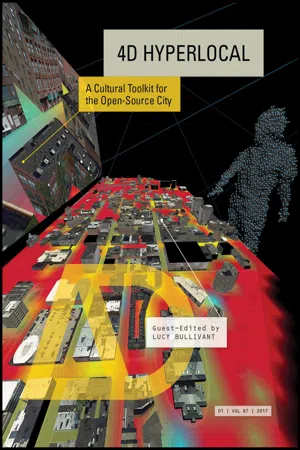
- English
- PDF
- Available on iOS & Android
About This Book
4D Hyperlocal: A Cultural Tool Kit for the Open-source City
The evolution of digital tools is revolutionising urban design, planning and community engagement. This is enabling a new 'hyperlocal' mode of design made possible by geolocation technologies and GPS-enabled mobile devices that support connectivity through open-source applications. Real-time analysis of environments and individuals' input and feedback bring a new immediacy and responsiveness. Established linear design methods are being replaced by adaptable mapping processes, real-time data streams and experiential means, fostering more dynamic spatial analysis and public feedback. This shifts the emphasis in urban design from the creation of objects and spaces to collaboration with users, and from centralised to distributed participatory systems.
Hyperlocal tools foster dynamic relational spatial analysis, making their deployment in urban and rural contexts challenged by transformation particularly significant. How can hyperlocal methods, solutions – including enterprise-driven uses of technology for bioclimatic design – and contexts influence each other and support the evolution of participatory architectural design? What issues, for example, arise from using real-time data to test scenarios and shape environments through 3D digital visualisation and simulation methods? What are the advantages of using GIS – with its integrative and visualising capacities and relational, flexible definition of scale – with GPS for multi-scalar mapping?
Contributors: Saskia Beer, Moritz Behrens, John Bingham-Hall, Mark Burry, Will Gowland and Samantha Lee, Adam Greenfield, Usman Haque, Bess Krietemeyer, Laura Kurgan, Lev Manovich and Agustin Indaco, Claudia Pasquero and Marco Poletto, Raffaele Pe, José Luis de Vicente, Martijn de Waal, Michiel de Lange and Matthijs Bouw, Katharine Willis, and Alejandro Zaera-Polo.
Featured architects and designers: AZPML, ecoLogicStudio, Foster + Partners, Interactive Design and Visualization Lab/Syracuse University Center of Excellence for Environmental Energy Systems, Software Studies Initiative/City University of New York (CUNY), Spatial Information Design Lab/Columbia University, Umbrellium, and Universal Assembly Unit.
Frequently asked questions
Information
Table of contents
- Cover
- Title Page
- Contents
- Copyright Page
- About the Guest–Editors
- Introduction The Hyperlocal: Less Smart City, More Shared Social Value
- Practices of the Minimum Viable Utopia
- The Posthuman City: Imminent Urban Commons
- Projective Empowerment: Co-creative Sustainable Design Processes
- Biodigital Design Workflows: ecoLogicStudio’s Solana Open Aviary in Ulcinj, Montenegro
- The Hackable City: Citymaking in a Platform Society
- From Citizen Participation to Real Ownership: Driving the Regeneration of Amsterdam’s Amstel3 District
- Imagined Community and Networked Hyperlocal Publics
- Conflict Urbanism, Aleppo: Mapping Urban Damage
- Suburban Resonance in Segrate, Milan: The Language of Locative Media in Defining Urban Sensitivity
- VoiceOver: Citizen Empowerment Through Cultural Infrastructure
- Digital Neighbourhoods: Hyperlocal Village Hubs in Rural Communities
- Sentiment Architectures as Vehicles for Participation
- AD 4D Hyperlocal Would Like to Use Your Current Location
- The Image of a Data City: Studying the Hyperlocal with Social Media
- Check–In: Foursquare and the Rich Annotated Topology of Citizen-Generated Hyperlocal Data
- Counterpoint Tell 'Em They're Dreamin'
- Contributors
- What is Architectural Design?
- Forthcoming Titles
- Back Cover
- EULA